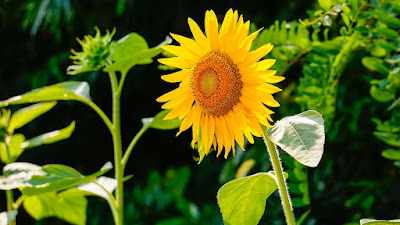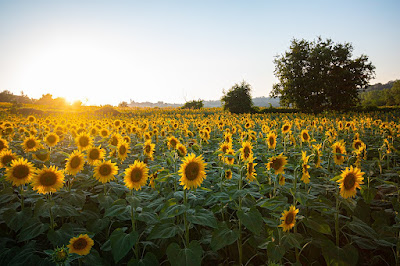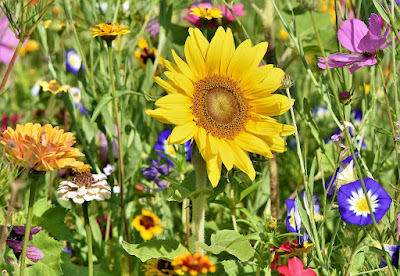Sunflowers: A Complete Guide to Appearance, Growth, Cultivation, Uses, and Symbolism
People all throughout the world are in awe of sunflowers (Helianthus annuus), which are recognizable and colorful flowering plants. These towering, herbaceous beauties have been nurtured and treasured for ages due to their remarkable look and intriguing growth patterns. Sunflowers are a well-liked sign of optimism and happiness because of their huge, brilliant yellow flower heads, which stand for happiness, warmth, and hope.
Their special quality of heliotropism, in which immature sunflowers trace the passage of the sun across the sky, contributes to their charm and enigma. Sunflowers are native to North America, but they've crossed cultural boundaries and are now produced for a variety of functions in other places.
Around the world, sunflowers have found their way into gardens and people's hearts as a repeating emblem of the beauty and richness of nature. They are utilized to make nutritious seeds and an all-purpose oil, and they also adorn floral arrangements and landscapes.
1. Appearance Sunflowers: The Captivating Beauty of Nature's Sunburst
 |
| Sunflowers (Helianthus annuus) |
Depending on the cultivar, the flower heads might have many layers (double-flowered) or a single layer (single-flowered). Additionally, sunflowers yield tasty, highly oil-rich seeds. They are a popular option for flower arrangements, landscapes, and decorative gardens because of their striking appearance and distinctive construction.
2. Growth From Seeds to Sunburst: The Lifecycle of Sunflowers
 |
| Sunflowers |
Upon reaching maturity, the blooms typically face eastward to maximize their exposure to the morning sun. The flower heads yield seeds when they have finished blooming and have been pollinated. The sunflower plant completes its life cycle as the growth season draws to an end. Mature seeds are left behind for future propagation and distribution, and the leaves and flower heads wither.
3. Cultivation Sunflowers: Tips for Growing Nature's Brightest Blooms
 |
| Cultivating sunflowers |
• Maintenance and Watering: Although sunflowers can tolerate some drought, they still need regular watering, especially during dry seasons. Plants need enough space from one another to breathe easier and prevent crowding, both of which reduce the risk of fungal infections.
• Pests and illnesses: Sunflower plants can be threatened by aphids, caterpillars, snails, and fungi that cause illnesses like powdery mildew. Efficient management of these issues can be facilitated by maintaining a clean garden and utilizing organic pest control methods.
• Harvesting: The plant's bloom heads must reach full maturity before gathering seeds for consumption or oil extraction. When the blossom heads go brown and dry in the back, it's time to harvest the seeds. Remove the plant tops, then let the plants dry out even more inside before collecting seeds.
4. Heliotropism Following the Sun's Path: The Enigmatic Heliotropism of Sunflowers
 |
| Sunflowers' growth |
• Definition :- Heliotropism is the ability of a sunflower to sense and follow the sun's journey across the sky.
• Sunflower Movements :-Young sunflowers have a distinct, heliotropic movement pattern while they are still in the bud stage. Towards the rising sun, the flower heads face eastward during the day. As the sun advances westward during the day, the flower heads sway and move with it. They leave in the dark and go back east, eager for the next day to arrive.
• Origin: Differentiating rates of stem cell proliferation are the source of the heliotropic movement observed in sunflowers. During the day, the flower head leans westward due to the longer cells on the western side of the stem than the other. The flower head turns eastward at night as the eastern side of the stalk elongates. The sunflower appears to be "tracking" the sun early in its growth when it regularly exhibits this behavior.
• Significance :- Heliotropism is believed to offer some benefits to the sunflower. In the bud stage, it maximizes the flower head's exposure to sunlight, aiding in the plant's energy production and growth. However, as the flower head matures and becomes heavy with seeds, the heliotropic response diminishes, and the flower heads typically face eastward permanently. This eastward orientation likely serves to protect the developing seeds from excessive heat and direct sun exposure.
5. Nature's Pollinators : The Vital Role of Bees in Sunflower Reproduction
 |
| Pollination play's with sunflower |
• Attraction to Bees :- Sunflowers have evolved to attract various pollinators, with bees being the primary agents of pollination. The bright yellow color of the sunflower heads acts as a visual attractant to bees, signaling the presence of nectar.
• Pollination Process :- As bees forage for nectar, they brush against the reproductive parts of the sunflower's florets. Each sunflower head contains two types of flowers - ray florets and disc florets. The ray florets are located around the edge of the flower head and are sterile, while the disc florets are in the center and produce fertile seeds. As bees move from flower to flower, collecting nectar, they inadvertently transfer pollen from the male reproductive organs (anthers) of the disc florets to the female reproductive organs (stigma) within the same or neighboring flowers.
• Cross-Pollination :- There's a possibility that bees from various plants will pollinate sunflowers when they come. Transferring pollen from one sunflower plant to the stigma of a flower on another sunflower plant results in an increase in genetic variation within the population.
• Seed Development :- The process of seed development begins within sunflower disc florets with successful pollination and fertilization. The flower head of the sunflower transforms into the recognized sunflower seed head when the seeds ripen and the petals begin to fade.
• Ecological Importance :- The vibrant colors and abundant nectar of sunflowers make them an important ecological symbol for pollinator health and biodiversity in their surrounds.
6. Uses Sunflowers : Beyond Beauty - Nourishment, Oil, and More
 |
| Sunflower seeds |
• Sunflower Oil : Crushed sunflower seeds are the basis for sunflower oil, which is among the most widely used vegetable oils worldwide. Owing to its superior taste, elevated smoke point, and supplementary health advantages, sunflower oil is incredibly popular. This is a heart-healthy cooking oil because of its high vitamin E concentration and low saturated fat percentage. Recipes for cooking, salad dressings, and baking frequently call for sunflower oil. Processing-related foods include it.
• Ornamental Value : Sunflowers are a popular choice for ornamental gardens and landscapes because of their vivid and fascinating appearance. This adds to their ornamental value. Their tall stems and big bright yellow flower heads brighten outdoor areas with a bit of joy. Sunflowers brighten homes and events with a hint of summer and are frequently used in bouquets, centerpieces, and floral arrangements.
• Biodiesel Production: Using sunflower oil as a feedstock can help the renewable energy industry produce biodiesel. Due to its reduced emissions of greenhouse gases and other harmful substances, biodiesel derived from sunflower oil is regarded as a more environmentally friendly fuel than traditional fossil fuels.
• Phytoremediation :- Sunflowers possess a special ability known as phytoremediation, which involves extracting and accumulating heavy metals and other pollutants from contaminated soil. This characteristic makes plants valuable in the phytoremediation process, which cleans up contaminated areas.
• Animal Feed: Sunflower meal or cake, a byproduct of sunflower oil extraction, is fed to cattle and fowl as a high-protein source of feed.
7. Symbolism Sunflowers: Symbol of Joy, Optimism, and Abundance
 |
| symbolic significance |
• Happiness and Positivity :- Sunflowers are often associated with optimism, love, and pleasure, as well as satisfaction and positive energies. They feel warm and content because of their sun-like brilliance and shimmering nature.
• Optimism and Endurance :- Sunflowers are thought to follow the path of the sun, signifying hope and the will to seize life's most fortunate chances. This quality has led to their representation of bravery and tenacity in the face of difficulty.
• Harvest & wealth: Sunflowers are associated with harvest festivals and the wealth of natural bounties in many civilizations. They provide as a picture of an abundant harvest season.
• Loyalty and admiration: Sunflowers are a considerate and treasured gift for family and friends because of their symbolism, which encompasses ideas of loyalty, admiration, and enduring friendships.
• Spirituality and Worship: Sunflowers are significant in many civilizations' spiritual and religious traditions. They are connected to sun gods and goddesses, signifying their capacity for regeneration and life-giving.
• Cultural Relevance: The symbolic implications of sunflowers have been further ingrained in human society by their inclusion in literature, art, and folklore.
In conclusion
Sunflowers, with their bright blossoms and distinctive growth habit, are a wonderful and adaptable gift from nature. Sunflowers have earned their place in both the practical and symbolic domains due to their alluring beauty and significant contribution to seed generation and pollination.
Sunflowers are a global source of inspiration and joy for numerous individuals, whether they are used to decorate gardens and landscapes, provide healthy seeds and oil, or represent happiness and hope. Let us be mindful of sunflowers' significance as a source of inspiration and an enduring symbol of the beauty and resiliency of the natural world as we enjoy their timeless appeal.

Join the conversation